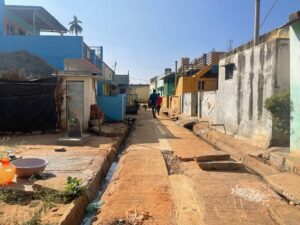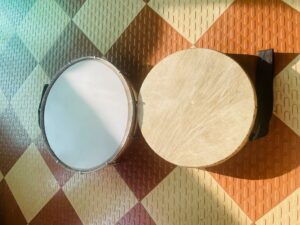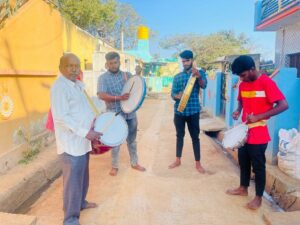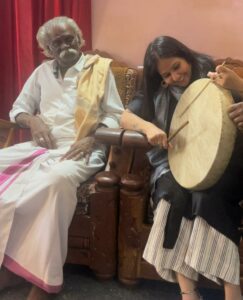Government support is required for both the artist and art form to preserve this slice of Dalit identity for years to come.

Munivenkatappa posing with his thamate. He was awarded the Padma Shri. (Chetana Belagere/South First)
The stench from the putrid water in the open drain hits hard, and mosquitoes and houseflies buzz even during daytime on the street leading to Nadoja Pindipapanahalli Munivenkatappa’s two-bedroom house at Madiga Colony.
For the past few days, a steady stream of visitors has been passing through the narrow street on the outskirts of Shidlaghatta village in the Chikkaballapura district, about 67 km from Benglauru.
Garlands, bouquets, boxes of sweets have piled up in 72-year-old Munivenkatappa’s house. The septuagenarian’s expertise in playing ‘Thamate’ — Dalit drum — has brought the Padma Shri and a host of visitors, including MLAs, MPs and ministers, to the colony.
Clad in a white shirt and dhoti with a rose border, and a neatly folded shawl casually thrown over his left shoulder, a timid Munivenkatappa sports a pale smile beneath his brooding white moustache: “My thamate speaks more than I do. I will try to answer you, but I cannot assure that I will be good in it,” he told South First.
The drum has become part of his identity, which the nation gracefully acknowledged. Looking back, Munivenkatappa recalled the travails of the Thamate artist, forced to remain in the shadows of the society’s backyard, and again, forcefully made to appear during funerals and festivals, playing the drum.
Still, they did not speak. The thamate did.
“The Madiga community is somewhere at the bottom of the caste hierarchy in India. In those days, I remember, my father Papanna used to go to villages to play this drum at funerals, fairs and some village festivals,” the Padma awardee recalled.
A short pause later, he added: “It was not by choice (that we played the drum), but quite often by force. If my father refused, we used to be hung from trees and beaten up by the village leaders. So, beating the drum was the only way to get grains such as finger millet, sorghum or rice once a year.”
The percussion instrument, made of goatskin, he said, kept the pot boiling at home during his childhood, and brought him recognition.
Yet, the society’s perception of Madigas, apparently, hasn’t changed, as the stench and buzz of insects enveloping about 30 houses at the colony in Health Minister K Sudhakar’s district quietly explained.

Madiga Colony in Pindipapanahalli where Munivenkatappa, Padma Shri awardee, resides (Chetana Belagere)
“This is the state of our community. Our children do not have much education,” Munivenkatappa’s son Prasanna M told South First.
A second pre-university pass, the younger man works as a waterman in the village.
“Due to various constraints we drop out after Class 12. We still work as manual scavengers, or daily-wagers. Very few have gone through the caste ceiling to achieve something in life,” he said.
Prasanna recalled seeing his father struggling day and night visiting various fairs, festivals and funerals with the thamate on one arm and sticks in his hand.
“He used to return with a meagre amount and bleeding fingers,” he added.
However, Munivenkatappa is brimming with pride. He is happy that those in Delhi have heard his thamate.
“I learnt this art as a proud son. It was by choice. We were three brothers and both my brothers played very well. I took to this art form just by accompanying my father Papanna, who was a professional,” he said.
“I started late at the age of 17. It took me about one-and-a-half years to master the beats and hand movements,” he added.
The journey, so far, was not smooth. Besides playing at fairs and funerals, Munivenkatappa and his brothers worked as daily-wage labourers to make both ends meet.
The caste devil kept them out of most of the jobs. The brothers would go to mulberry farms rearing silkworms, chop wood and sell them for a living.
“I married my relative. She is from Srinivaspura. I had four children but my son died at the age of 14 and my elder daughter was only six months old when I lost my father,” the artist said.
“My brother’s children Prasanna and Madhu are now my sons. My three daughters are married,” he introduced his family to South First.
The turning point in Munivenkatappa’s life came when HL Nage Gowda, a Kannada folklorist, noticed him performing at a temple fair at Devaramallur village in Sidlaghatta taluk. Gowda felt the artist deserved a wider audience.
“Thanks to him, my thamate was heard not only in Karnataka and others Indian states, but also in Japan and twice in America,” he said with a glint of pride in his eyes.
A normally coy Munivenkatappa waxed eloquent while speaking about Gowda.
“Considering the community I come from, and the stigma and taboos attached to the thamate, I would have never, even in my wildest dream, imagined of stepping out of my village and its neighbourhood,” the Dalit artist said.
“He took me to almost all districts in Karnataka, several states like Andhra Pradesh, Tamil Nadu too and gave me the opportunity to play this Dalit instrument and spread its magic even in countries like America and Japan,” he said.
The Padma Shri has brought immense happiness and pride to Munivenkatappa and his family. The future, however, worries the artist who has won more than 50 awards.
He is reluctant to speak about the hardships he face in life. But Prasanna spoke.
“Thanks to various governments for recognising my father’s talent. It’s been more than 30 years since he received the Rajyotsava Award in 1992,” he began.
“The then Tahsildar gave us about three acres in the village. But that land is under litigation and we still don’t have any rights over it,” he explained.
Meanwhile, after winning the Nadoji Award in 2016, he was allotted a Bangalore Development Authority site. Munivenkatappa raised an advance of ₹26,000. The state government later demanded an advance of ₹five lakh to avail the site.
“I told the officers that I don’t have ₹5 lakh. It’s a huge amount. Then, I got a notice too. Look at the coincidence. Just 15 days before I got the Padma Shri, I received a notice saying the BDA site allotted to me has been cancelled,” Munivenkatappa lamented.
A letter informing him about cancellation of the site, number B4-SA-70 in Bengaluru’s Nadaprabhu Kempe Gowda Layout in 2016, for non-payment of the prescribed amount was sent to him on 5 January.
Munivenkatappa and his family, through South First, appealed to the state government to direct the BDA to reconsider its decision and re-allot the site without any payment.
Munivenkatappa and his family explained more about the thamate. His elder daughter, Parvathamma, desired to learn the art form and even tried it. But she had to drop her plan due to caste norms that prohibited girls from performing in the streets.
Parvathamma, however, has keenly observed how the instrument is made.
“It is a humongous process. I have seen my father bringing the goatskin home. He would them stretch the skin to smoothen the wrinkles. Then some ash is spread over it before drying the pelt for 10-15 days,” she explained.
“Later, it would be soaked in water and stretched to the desired shape. It is then woven around a thick metal ring. One person can’t do it. At least three to four people would sit together and make one thamate,” she said.
Parvathamma said the thamate should be kept out in the sun before taking out. Normally, the artist would carry dry grass or newspapers to light a fire and warm up the drum a bit for tuning it.
“These days the goatskin thamate has been replaced by fiber ones,” Parvathamma said.
The fibre drums are louder. There are a few manufacturers who make and market such drums.

Thamate made with goat skin (on the right) and the fiber one (on the left) displayed. (Chetana Belagere)
Munivenkatappa said he is among a few in the village who could make the instrument.
To learn this art, “it will take a minimum of three months. One has to first learn to hold the sticks in his hands. His arms should be strong to play the drum and able to keep it on his shoulders,” Munivenkatappa explained, adding that the students are initially taught 32 beats.
This correspondent tried her hands at the thamate, and realised that it requires more strength to play the instrument.
Munivenkatappa’s cousin Devaraj revealed another trait of the otherwise shy artist. “My brother is very short tempered. If we get any beat wrong, he would throw at us whatever he could lay his hand on. I have been hit several times while learning the instruments,” he grinned.
Devaraj plays the dollu, a double-headed drum, in Munivenkatappa’s troupe.
The Department of Kannada and Culture once asked Munivenkatappa to ensure that the art form is taught at various locations in the state.
However, after one such workshop in the Shidlaghatta district, the department scrapped the programme citing lack of funds.

Munivenkatappa’s sons Madhu and Prasanna along with uncle Devaraj playing thamate (Chetana Belagere)
Meanwhile, Munivenkatappa said the thamate, which is a representation of the Dalit culture is considered a taboo and not many people are willing to to learn it.
“The art will die if it is not taught to the young generation. If the art dies, it’s also the death of Dalit culture. The taboo around this should be removed,” he said.
Munivenkatappa has a suggestion. “Educational institutions, and universities should encourage the teaching this art form,” he added.
He has taught the art form to sons Prasanna and Madhu, who also give stage shows and attend several invited functions.
However, Prasanna said it would be beneficial if the state government creates a theatre space for the continuation of this art form.

Additional strength is required to play the thamathe, this correspondent has realised. (South First)
“My father is ageing. He has taught us to play the drum. He still can play the drum and teach it. One must not ignore this art form. If the government could provide a small space to hold classes and to showcase the art form, it would go a long way in helping this Dalit art form survive,” he added.
So, how does Munivenkatappa feel on getting the Padma Shri?
Iga nemmadi (I am satisfied), the septuagenarian said with a twinkle in his eye. “This is a win for Dalits and it shows that even a backward caste community can shine. My thamate has made its voice loud and clear. Will others join in,” he asked with a smile.

Jul 27, 2024

Jul 26, 2024

Jul 26, 2024

Jul 26, 2024

Jul 26, 2024

Jul 26, 2024